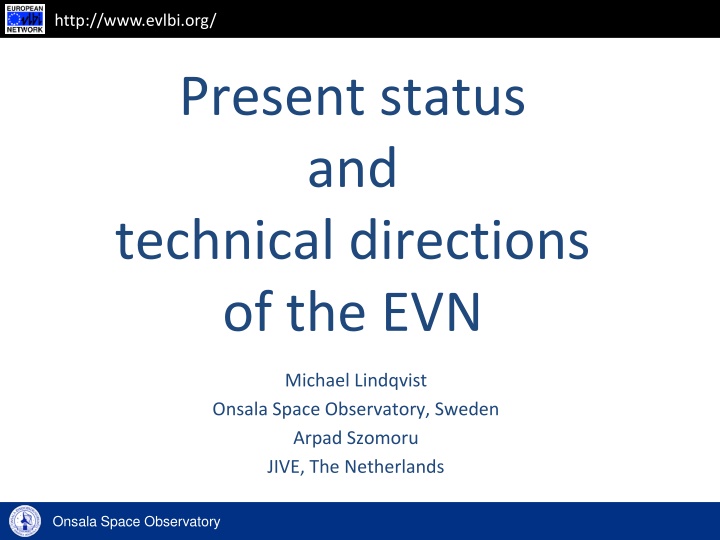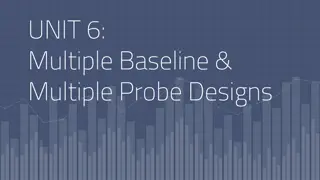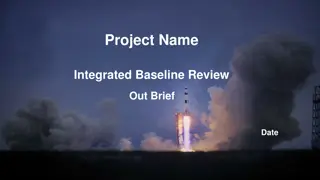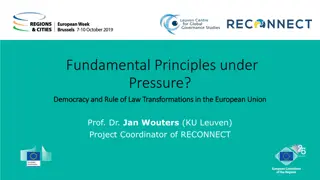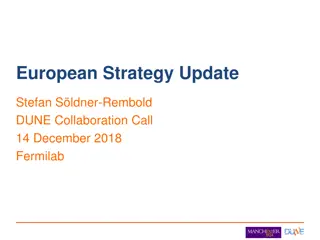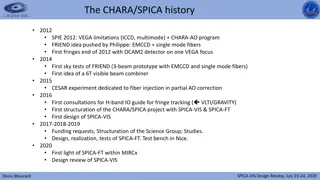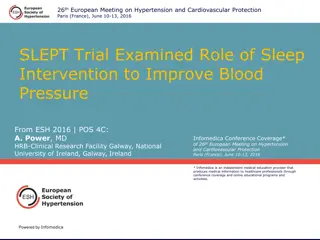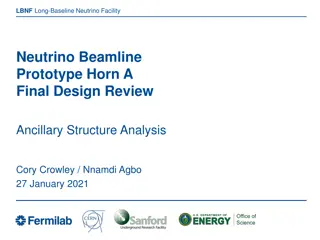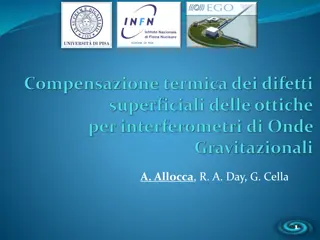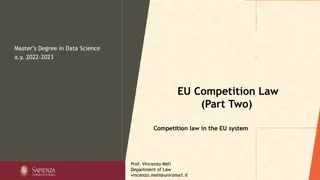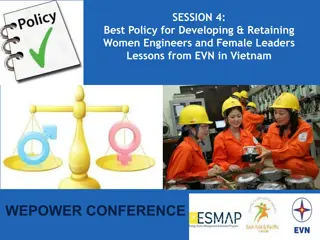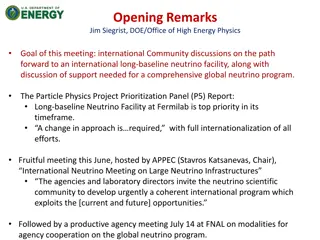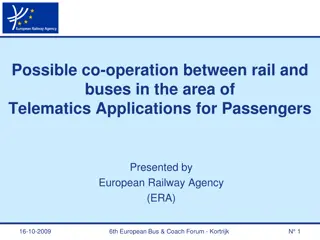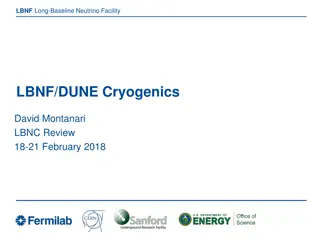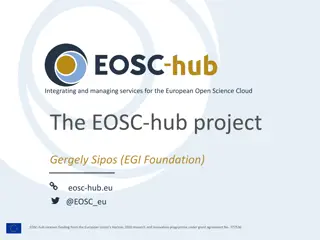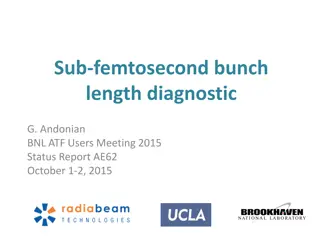Overview of European Very Long Baseline Interferometry Network (EVN)
The European Very Long Baseline Interferometry Network (EVN) is a collaborative effort among major institutes in Europe to conduct advanced astronomical observations using a network of radio telescopes. The EVN, established in 1980, facilitates innovative research through effective collaboration, technological advancements, and operational enhancements. With a focus on real-time capabilities and future opportunities, the EVN aims to advance the field of Very Long Baseline Interferometry (VLBI) to explore the mysteries of the universe.
Download Presentation

Please find below an Image/Link to download the presentation.
The content on the website is provided AS IS for your information and personal use only. It may not be sold, licensed, or shared on other websites without obtaining consent from the author.If you encounter any issues during the download, it is possible that the publisher has removed the file from their server.
You are allowed to download the files provided on this website for personal or commercial use, subject to the condition that they are used lawfully. All files are the property of their respective owners.
The content on the website is provided AS IS for your information and personal use only. It may not be sold, licensed, or shared on other websites without obtaining consent from the author.
E N D
Presentation Transcript
http://www.evlbi.org/ Present status and technical directions of the EVN Michael Lindqvist Onsala Space Observatory, Sweden Arpad Szomoru JIVE, The Netherlands Onsala Space Observatory
http://www.evlbi.org/ Outline Description of the EVN Present status Future directions and possibilities Summary Onsala Space Observatory
http://www.evlbi.org/ Difficult to predict the future The operational performance of the European VLBI Network depends on the effective collaboration of national observatories, the large collecting areas available at those observatories, and its success in incorporating the advances in technology. Target-of-opportunity capability and e-VLBI operation will contribute to robust and flexible operational procedures. Seamless EVN-MERLIN integration as the short baseline core of EVN can be achieved by adding EVN antennas to MERLIN and connecting the e-Merlin telescopes into the EVN correlator at JIVE. The increased correlation capability at JIVE of up to 256 Gb/s per radio telescope for routine operations with 32 stations will facilitate innovative research with EVN2015. Onsala Space Observatory
http://www.evlbi.org/ From the 60 s to real-time VLBI O. Rydbeck J. Elld r B. Hansson First transatlantic VLBI, Onsala, Sweden, 1968 Real-time demo during opening ceremony of IYA, 15-16 January 2009 in Paris Onsala Space Observatory
http://www.evlbi.org/ Description of the EVN The European VLBI Network (EVN) was formed in 1980 MPIfR (Germany), IRA (Italy), ASTRON (The Netherlands), OSO (Sweden), JBO (UK) Today it includes 15 major institutes, including the Joint Institute for VLBI in Europe (JIVE) EVN has no central funding Onsala Space Observatory
http://www.evlbi.org/ Onsala Space Observatory
http://www.evlbi.org/ Description of the EVN EVN CBD A. Zensus EVN EVN PC EVN TOG Scheduler T. Muxlow A. Gunn M. Lindqvist Onsala Space Observatory
http://www.evlbi.org/ Description of the EVN EVN CBD A. Zensus EVN EVN PC EVN TOG Scheduler T. Muxlow A. Gunn R. Porcas M. Lindqvist Onsala Space Observatory
http://www.evlbi.org/ The EVN wheel Correlation EVN Session TOG- meeting EVN schedule CBD- meeting PC- EVN symp. meeting EVN prop. Onsala Space Observatory
http://www.evlbi.org/ Proposal trend across 9 years 90 80 70 60 Global 50 eVLBI EVN 40 Total 30 20 2014 final figures assume an average of 11 ToOs/year 10 Muxlow 0 2006 2007 2008 2009 2010 2011 2012 2013 2014 Introduction of Mark 5 recording system (game changer) Emergence of high bandwidth optical fibre networks (EXPReS, NEXPReS) Onsala Space Observatory
http://www.evlbi.org/ Current status Maximum Angular Resolution in milliarcseconds Array 90 cm 18 cm 6 cm 3.6 cm 1.3 cm 0.7 cm EVN - 15 5 3 1 0.6 EVN (inc. SH/Ur) 30 5 1.5 1 0.3 0.15 EVN+VLBA 19 3 1 0.7 0.25 0.13 Telescopes, 14 300 m Data rate 1 Gbps (2x128 MHz, 2-bit sampling) Global observations @ 1 Gbps Disk recording/e-VLBI Digital backends (DBBC2, CDAS, RDBE, R1002, DVP), recorders (mostly Mark 5) Typically 50-60 Tb/station per session. Record > 1000 TB for a session Record: A 23 station global experiment. EVN Software Correlator at JIVE (SFXC) Onsala Space Observatory
http://www.evlbi.org/ Observing sessions The EVN observes during: 3 EVN sessions (3x3 weeks) 10 e-VLBI sessions (10x24 hours) Target of Opportunity Out of Session The VLBI friends performs the observations Onsala Space Observatory
http://www.evlbi.org/ Typical EVN Session Frequency block 1 Frequency block 2 Network Monitoring Experiment (NME) Network Monitoring Experiment (NME) (fringe tests) (fringe tests) Calibration Calibration (rxg-file) (rxg-file) User experiment User experiment Correlator Users ANTAB-, UVFLG- files ANTAB-, UVFLG- files Onsala Space Observatory
http://www.evlbi.org/ TOG-meetings Reports from JIVE Calibration! Discussion about previous sessions Current & new instrumentation Technical priorities Reports from NRAO and Haystack Development: e.g. 64 Gbps with ALMA SRT, October 5, 2014 CBD Onsala Space Observatory
http://www.evlbi.org/ What does the user want? Average rank In which direction should the EVN develop? 2.73 Improved uv-coverage (more telescopes, more short spacings) 3.50 Increased bandwidth to improve sensitivity 4.57 Improved calibration in general (phase, amplitude, bandpass, polarization) 4.60 Improved resolution (more long baselines) 4.73 Frequency agility for spectral index imaging 6.06 Real-time e-VLBI capabilities for more telescopes 6.34 Extended observing time to be able to carry out big surveys 6.42 Real-time e-VLBI capabilities for a larger fraction of observing time 6.71 Improved astrometry 6.89 Larger field of view Onsala Space Observatory
http://www.evlbi.org/ Enhancing EVN capabilities New observing modes EVN+LBA Out-of-Session (up to a maximum of 144 hours/year) Triggered/interrupted e-VLBI observations Disk recording and e-VLBI simultaneously (NEXPReS) A successful 4 Gbps recording/streaming demonstration was done on September 18, 2013, during the final review of NEXPReS New telescopes and collaborations e-Merlin with all out stations at 1 Gbps (and beyond) KVN, RadioAstron, Irbene, SRT, China, AVN, MeerKAT Sub-arrays, more observing time with smaller telescopes 1 APERTIF beam of 12 WSRT dishes added to the EVN SKA Onsala Space Observatory
http://www.evlbi.org/ Enhancing EVN capabilities e-VLBI/e-transport High speed connectivity to, KVAZAR, KVN, Urumqi, Diskshipping-less operations in the EVN (1 Session 50-60 TB /station) see poster, H. Verkouter 100 Gbps technology rolled out Bandwidth on Demand (BoD) standard to be implemented by NRENs Clocks, frequency via commercial networks Next generation receivers, backends and recording systems Broadband receiver 1.6 5 GHz (RadioNet3 JRA DIVA) DBBC3 32 Gbps (DIVA, next talk by Alef) Mark 6, Flexbuff (NEXPReS) Observations at 2-4 Gbps (and beyond) Next generation correlators, SFXC, UniBoard Onsala Space Observatory
http://www.evlbi.org/ New observing modes Triggered/interrupted e-VLBI observations Shortening the trigger timescales would be valuable to probe a new transient parameter space in the EVN We have (soon) a system in place that can interrupt/trigger a new observation within 5-10 minutes (or so) Will open up generic triggered interrupt programmes The aim is to offer this mode in 2015 Onsala Space Observatory
http://www.evlbi.org/ 2 - 4 Gbps in the EVN Mixed mode tests Different backends, February 2013 Bottlenecks? Disk media Field System: (DDC/PFB/FILA10G) DBBC2: software (DDC 32 MHz) 2 Gbps, 2015 Discussion at users meeting Which band(s) first? C-, X-, K- and Q-band. Science impact? Onsala Space Observatory
http://www.evlbi.org/ EVN Software Correlator at JIVE (SFXC) The birth of SFXC - tracking of Huygens probe during descent to Titan First science project correlated in fall 2011 SFXC primary correlator for disk recorded data since summer 2012 Hardware correlator was closed down 2012 First real-time e-VLBI in December 2012 No MarkIV correlation since then e-VLBI with 13 stations @ 1 Gbps Main Features Data formats: Mark4, VLBA, Mark5B, VDIF Pulsar gating Possibility to combine gating and binning (practically) Unlimited spectral resolution Multiple phase centres (under development, real time) Phased array mode (see EVN Newsletter #37, January 2014) See Poster, M. Kettenis Onsala Space Observatory
http://www.evlbi.org/ JIVE UniBoard Correlator (JUC) UniBoard: EC-funded, led by JIVE JRA in RadioNet FP7 (also in RadioNet3) Create generic, high performance computing platform for radio astronomy FPGA One board roughly equivalent to the MarkIV correlator Real results Close to commissioning Onsala Space Observatory
http://www.evlbi.org/ SXFC vs JUC Software: Fantastically flexible Easy to modify, improve, extend, expand, upgrade Hardware gets cheaper as time goes by Development effort and the effort needed to make it into an operational system grossly underestimated Definitely not suited for heavy lifting ~13 stations on current SFXC cluster at 1 Gbps 16 stations at 4 Gbps: factor of ~5 more hardware needed FPGA: Once it works, it goes like the clappers Perfect for simple operations Not nearly as flexible Hard(er) to develop/debug/modify/upgrade firmware 16 stations on 2 available UniBoards at 2 Gbps 4 Gbps: factor 2 Onsala Space Observatory
http://www.evlbi.org/ Summary Development can come either bottom-up (new technology looking for astronomical uses) or top -down - (defining astronomical problems first and finding technical solutions afterward). EVN does both. Communication and scientific interaction between engineers and scientists involved in the development and operation of radio astronomical instruments, such as the EVN, is very important. EVN is making use of and drive technical progress The future for the EVN is looking bright and it will complement the SKA Onsala Space Observatory
